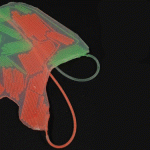Plastic solar cells could pave the way for a clean energy industry.
Plastic may soon replace silicon when it comes to making solar cells; building developers are already looking at ways to integrate them into their designs and using plastic solar cell-coated window panes. And PhD student Anirudh Sharma from Flinders University may have developed the product they’re looking for.
His concept, which he presented in Flinders University’s 2012 Three Minute Thesis competition, involves depositing materials on two differently electrical surfaces. This method avoids the degradation problem that arises from the current fabrication process. “In the conventional method of fabricating plastic solar cells you have to deposit various materials sequentially on top of each other in a sandwich structure but over time the materials intermix, leading to device degradation,” he explains.
The plastic cells were then laminated, giving him better control over the material intermixing and resulting in a more stable, better performing device. The lamination method could be also integrated with printing machines — the materials can be deposited by printing and devices can be fabricated by lamination at the same time.
This would make the entire process scalable at relatively lower costs, Sharma says. “This is a much cheaper way of fabricating solar cells because you can make a large number of devices in a very short time, and this method of self-encapsulation can potentially help improve the life-span of the device as well.”
Sharma’s new method not only provides an alternative to the expensive fabrication techniques currently used in the renewable energy sector; it would also make the commercialisation of plastic solar cell technology more viable and could pave the way for a lucrative clean energy industry, as it’s cost effective and the cells can be made quickly — these have always been two of solar energy’s biggest limiting factors.
Current methods of producing solar cells are expensive — most of the solar cells that we’ve seen on rooftops until now have been made from silicon, which takes large amounts of energy to purify. Scientists began looking at plastic solar cells fifteen years ago, but the current fabrication methods are still relatively expensive and time consuming, Sharma says.
“Plastic solar cells, on the other hand, are really light and flexible so they can be used to coat a whole range of different surfaces — they are portable enough to put them on day to day carry bags and even camping tents — and plastic itself is cheap as chips.”
Source: Flinders University








Md. sharefur rahman
September 29, 2012
good job